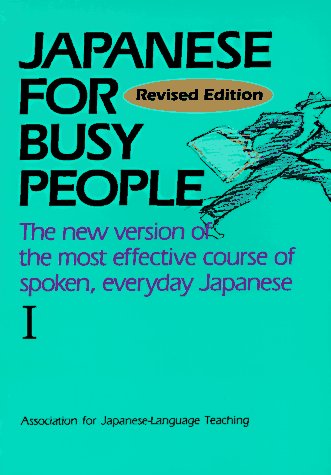More than a decade ago, when I started getting serious about my studies in foreign languages and linguistics, Japanese for Busy People was one of the first books I became attached to. In my humble opinion, it is a perfect example of what every introductory language textbook should be, both in terms of content and presentation. Even though the book has now been in use for almost thirty years, I think that it is still one of the best choices available today for beginning Japanese learners.
The beauty of Japanese for Busy People lies in its structure. Not only does the format of the book make sense linguistically and pedagogically, its consistent and easy-to-follow structure make for a streamlined learning experience both inside and outside of the classroom.
Each lesson follows this basic progression:
-Dialogue/Narrative English translation
- Vocabulary list
- Grammar explanations
- Notes on word usage, culture, etc.
- Key sentences and Exercises
- Vocabulary list for exercises
- Short dialogue(s)
- Vocabulary list
-“Quiz”
It may seem like a lot when listed like this, but each lesson is short and compact, giving students a feeling of constant progression. The dialogues are never too long, and focus on straightforward communicative acts using a level of formality in Japanese that is not overly polite, nor overly familiar. It is very clear what each lesson is driving the students to achieve, be it a particular feature of the grammar, or a specific language task, and this clarity helps students stay focused and motivated. The grammar explanations use clear and concise language, providing plenty of examples where necessary. All of the exercises drill vocabulary and grammar which was introduced in the opening dialogue to give students practice manipulating the language themselves. Vocabulary is presented in lists according to order of appearance, not alphabetically, which I think makes things easier to reference as you go along. At the end of the book you can find answers to the “Quiz” questions, grammar appendices, and the obligatory Japanese-English, English-Japanese glossaries. There is nothing at the beginning of the book to teach users Japanese pronunciation, but I think this is excusable given the relative ease of Japanese pronunciation, and the fact that there are many other resources available for learning this.
"I strongly urge all students and instructors to make use only of the kana version (which presents all the Japanese words in kana script) only. The romanized version may seem like an easy way out of having to learn the Japanese script, but I believe it will take away from the learner's experience, as well as delaying the inevitable for anyone planning on continuing their Japanese studies beyond a basic level."
The book is available in two versions – the kana version and the romanized version. I strongly urge all students and instructors to make use only of the kana version (which presents all the Japanese words in kana script) only. The romanized version may seem like an easy way out of having to learn the Japanese script, but I believe it will take away from the learner's experience, as well as delaying the inevitable for anyone planning on continuing their Japanese studies beyond a basic level. This book doesn't do much of anything in the way of teaching kanji (there are literally only two pages devoted to it), but I don't think learning kanji should be an immediate concern of the beginning Japanese student.
I really do not have anything bad to say about this book, but there are some points that students have told me they found challenging when I was using the book with them. First of all, the exercises introduce many vocabulary items that the student will have not yet encountered. While these items can all be found in the vocabulary list following the exercises, students have pointed out that it can turn into a distraction when they are trying to practice grammar and are continually having to flip back and forth to look up new words. Another issue students pointed out to me were the charts for learning numbers, days of the month, etc. All of a sudden students are presented with a giant chart of words that the book simply asks that they memorize. This can seem like a lot to swallow, especially if they feel like they cannot move on to the next lesson until they have mastered all of it. I would suggest anyone using this book to break these charts up into several smaller chunks that can be memorized little by little. The last thing was how the book often references grammatical terms that may not be familiar to the student. I believe that these can largely be understood through context, given the examples shown in the text, but instructors using this book in the classroom may want to spend some extra time making sure everyone understands all the grammatical terms used in the text.

Along with the main book, there are audio recordings and a workbook available to supplement the course. While I wouldn't consider either of these absolutely necessary (as long as the student is making use of an instructor or other resources for acquiring proper Japanese pronunciation), I do suggest that all students try to get their hands on these. The workbook provides a lot more exercises similar to those found in the textbook, which I think is great for beginning students who are going to need practice reading and writing Japanese script. I wouldn't say there's really anything special about the audio recordings, but they do give learners the opportunity to practice Japanese using another modality, which many students may find beneficial.
There is not much else for me to say about this book, aside from the fact that I love it. I think that it offers the perfect balance of input and exercises, a good rate of progression through the lessons, and a structure that makes learning easy. Not only is the content of this book great by itself, but it is also followed up by a second and third volume, which allow the student a single path leading them from beginner to intermediate level. With all the Japanese textbooks out on the market today, some may be tempted to try other books that have flashier covers or catchier titles, but I highly recommend taking a look at this title first.



